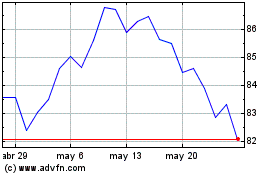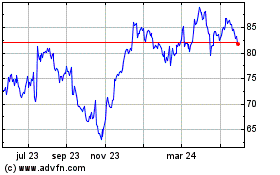Northern Trust Pension Universe Data: Canadian Pension Plan Returns Advanced in Q2 as Global Equities Gained Momentum
30 Julio 2024 - 10:00AM
Business Wire
Canadian pension plans witnessed a positive finish to the second
quarter, according to the Northern Trust Canada Universe. The
median Canadian Pension Plan returned 1.1 percent for the quarter
and 3.5 percent year-to-date.
The second quarter marked a pivotal shift in monetary policy to
a less restrictive tone in some developed regions, led by the Bank
of Canada (BoC) and followed by the European Central Bank (ECB). As
these two monetary authorities gained confidence in the path and
level of inflation, most other major central banks maintained a
cautious narrative as they continued to monitor progress in
bringing down inflation in a sustainable manner and in line with
their respective targets and mandates.
Financial markets were challenged with volatility early in the
period as geopolitical tensions mounted, combined with the release
of stronger economic data supportive of persistent inflation.
Despite the uncertainty, global equities marched higher throughout
the quarter, led by emerging markets, concluding the period with
attractive returns. Although Canadian equities posted a modest
decline as pockets of softer economic data emerged, the Canadian
bond market benefited from the BoC interest rate cut, resulting in
a rebound into positive territory for the quarter. The current
divergence in major central bank policies coupled with the Federal
Reserve’s (Fed) consistent messaging regarding the direction of
interest rates led to a modest strengthening of the U.S. dollar
over the quarter.
“As we conclude the first half of 2024, a theme of
sustainability permeated across the globe. We have seen it through
central bank actions as policymakers seek a sustainable path of
inflation in an effort to normalize monetary policy. This theme
continues to echo across the Canadian pension plan landscape as
plan sponsors demonstrate resilience and agility while navigating
the economic elements of high interest rates, persistent inflation
and waves of volatility,” said Katie Pries, President and CEO of
Northern Trust Canada.
The Northern Trust Canada universe tracks the performance of
Canadian institutional defined benefit plans that subscribe to
performance measurement services as part of Northern Trust’s asset
service offerings.
Despite a challenging economic backdrop in the second quarter,
corporate earnings remained strong and investor optimism prevailed,
leading to solid returns for global equities for the period.
Although the Canadian equity market witnessed weaker results
relative to its global peers, the Canadian bond universe welcomed
the first interest rate cut by the Bank of Canada (BoC) and closed
the quarter with a positive tone.
- Canadian Equities, as measured by the S&P/TSX Composite
Index, declined -0.5% for the quarter. The Materials and Consumer
Staples sectors were the top performers for the period. The Health
Care sector posted the weakest performance followed by the Real
Estate and Information Technology sectors.
- U.S. Equities, as measured by the S&P 500 Index returned
5.4% in CAD for the quarter, with the Information Technology and
Communication Services sectors leading performance with double
digit returns. The Materials, Industrials, Energy, Financials and
Real Estate sectors retreated during the period.
- International developed markets, as measured by the MSCI EAFE
Index, generated 0.9% in CAD for the quarter. Most sectors observed
positive returns led by the Health Care and the Financials sectors,
while the Consumer Discretionary and Real Estate sectors were the
most notable laggards during the period.
- The MSCI Emerging Markets Index advanced 6.3% in CAD for the
quarter. Most sectors achieved positive returns with the
Information Technology sector leading the index with strong
performance, while the Health Care, Consumer Staples and the
Materials sectors produced negative returns for the period.
The Canadian economy witnessed some early signs of slower
economic growth, disinflationary pressures along with softening
employment. Unemployment hit its highest level since early 2022,
rising to 6.4% in June, up from 6.1% in March. Although inflation
nudged higher in May relative to the previous month, the most
recent year over year figure in June of 2.7% highlighted that
Canadian inflation continues to cool.
The U.S. economy continued to exhibit strength during the
quarter despite softer patches of growth data. Progress on
inflation emerged, as CPI rose 3.0% in June (y/y) down from 3.5%
(y/y) in March. Despite the solid number of jobs added in the month
of June, the unemployment rate witnessed an unexpected rise to
4.1%, the highest since November 2021. The Federal Reserve (Fed)
maintained the Federal Funds Target Rate at 5.25% - 5.50%. The Fed
Chair emphasized the bank’s intention to only cut interest rates
once it has “gained greater confidence that inflation is moving
sustainably toward the committee’s 2% objective.”
International markets observed progress in efforts to bring
inflation closer to central bank targets. The European Central Bank
(ECB) lowered interest rates by 25 bps, marking the start of an
easing cycle for the ECB. Although inflation eased in June, the
committee remains cautious regarding its inflation outlook and
suggested further rate cuts would only come slowly. The Bank of
England (BoE) maintained its benchmark rate at 5.25%, despite
headline inflation dropping. The BoE justified its decision as it
“needs to be sure inflation will stay low” but signaled a rate cut
could be possible at its August meeting. The Bank of Japan (BoJ)
held rates steady at 0%-0.1% after hiking rates the previous
quarter.
Emerging markets gained momentum during the second quarter,
outperforming developed markets. Much of the outperformance was
attributed to investor interest in the AI/Chips space. The People’s
Bank of China (PBoC) held the one-year and five-year Loan Prime
Rates (LPR) steady at 3.45% and 3.95% respectively. The Central
Bank of Brazil dropped the key Selic rate by 25bps in May to 10.5%.
The Reserve Bank of India (RBI) also chose to keep rates steady at
6.5%.
The Bank of Canada (BoC) announced at its June meeting that
monetary policy “no longer needs to be as restrictive” and lowered
its benchmark policy rate by 25 bps to 4.75%. The BoC was the first
of G7 nations to cut rates, having held its policy rate at 5% since
July 2023.
The Canadian Fixed Income market, as measured by the FTSE Canada
Universe Bond Index, generated a gain of 0.9% for the quarter.
Corporate bonds outpaced Federal and Provincial bonds with all
three segments generating positive performance. All bond durations
witnessed gains for the quarter, with short-term bonds leading mid
and long-term bonds.
About Northern Trust
Northern Trust Corporation (Nasdaq: NTRS) is a leading provider
of wealth management, asset servicing, asset management and banking
to corporations, institutions, affluent families and individuals.
Founded in Chicago in 1889, Northern Trust has a global presence
with offices in 24 U.S. states and Washington, D.C., and across 22
locations in Canada, Europe, the Middle East and the Asia-Pacific
region. As of June 30, 2024, Northern Trust had assets under
custody/administration of US$16.6 trillion, and assets under
management of US$1.5 trillion. For more than 130 years, Northern
Trust has earned distinction as an industry leader for exceptional
service, financial expertise, integrity and innovation. Visit us on
northerntrust.com. Follow us on X (formerly Twitter) @NorthernTrust
or Northern Trust Corporation on LinkedIn.
Northern Trust Corporation, Head Office: 50 South La Salle
Street, Chicago, Illinois 60603 U.S.A., incorporated with limited
liability in the U.S. Global legal and regulatory information can
be found at https://www.northerntrust.com/terms-and-conditions.
View source
version on businesswire.com: https://www.businesswire.com/news/home/20240730366224/en/
Doug Holt (312) 557-1571 Dh124@ntrs.com
http://www.northerntrust.com
Northern (NASDAQ:NTRS)
Gráfica de Acción Histórica
De Jun 2024 a Jul 2024

Northern (NASDAQ:NTRS)
Gráfica de Acción Histórica
De Jul 2023 a Jul 2024
